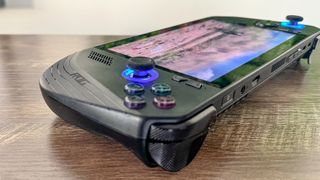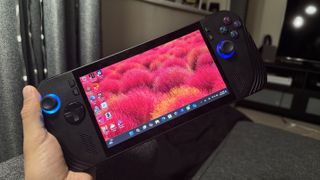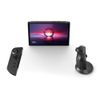Asus ROG Ally X vs Steam Deck OLED: Which gaming handheld wins?
Similar in nature, but very different in practise

The handheld gaming PC competition is really beginning to heat up, and the Asus ROG Ally X is ready to take on the dominant Steam Deck OLED.
And on paper, this should be an easy fight. Even though the Steam Deck does have that gorgeous OLED HDR panel to its advantage, the ROG Ally X packs a giant battery for great longevity, vastly superior internals, and with Windows 11, you’ve got access to all of your game launchers — rather than being limited to Steam.
But in reality, the answer to which one’s better is a little more complicated than that. Whether it’s how easy it is to use, the “pick up and play” ability or the hard work of developers to optimize games for Valve’s handheld, it’s a lot harder to pick between these devices than you may think.
Asus ROG Ally X vs Steam Deck OLED: Specs compared
| Header Cell - Column 0 | Asus ROG Ally X | Steam Deck OLED (1TB) |
|---|---|---|
| Price | $799 | $549/$649 |
| Chipset | AMD Ryzen Z1 Extreme | Custom AMD Zen 2 "Van Gogh" APU |
| Storage | 1TB PCIe Gen 4x4 SSD | Up to 1TB NVMe SSD |
| Memory | 24GB LPDDR5x | 16GB LPDDR5x |
| Operating system | Windows 11 | SteamOS |
| Display | 7-inch FHD, 16:9, 120Hz refresh rate IPS panel | 7-inch 1280 x 800 HDR OLED, 90Hz refresh rate |
| Ports | 1x USB 4 Type-C, 1x USB 3.2 Gen 2 Type-C, 1x 3.5mm audio jack, 1x microSD card reader slot | 1x USB-C, 1x 3.5 mm audio jack, 1x microSD card reader |
| Dimensions | 11 x 4.4 x 1.5 inches | 11.73 x 4.6 x 1.93 inches |
| Weight | 1.49 pounds | 1.4 pounds |
Asus ROG Ally X vs Steam Deck OLED: Price

This one is pretty open and shut. The Steam Deck OLED starts at $549 for the 512GB version — going up to $649 if you want a full 1TB of storage. Meanwhile, the Asus ROG Ally X comes in one configuration for $799.
That’s up to $250 more than the upgraded Deck, and puts the X in budget gaming laptop territory. It’s a steep one.
Winner: Steam Deck OLED
Asus ROG Ally X vs Steam Deck OLED: Design and display

Asus has pulled off something incredible here with the ROG Ally X’s display. Doubling the battery capacity should surely drastically increase the weight and thickness, but yet it doesn’t. In fact, I’d say the company has embraced this challenge and managed to improve the feel of this handheld by quite a margin.
With the 0.4 inches of increased thickness, Asus managed to make the grips more pronounced for a better hold of the machine. Alongside this, the triggers are more comfortable with better travel, the D-Pad and face buttons have a nice tacility, and the joysticks are oh-so smooth while also being durable.
| Device | Dimensions | Weight |
|---|---|---|
| Asus ROG Ally X | 11 x 4.4 x 0.9 inches | 1.49 pounds |
| Steam Deck OLED | 11.73 x 4.6 x 1.93 inches | 1.4 pounds |
If there was no such thing as a Steam Deck, this would be the best handheld to hold. But Valve’s handheld exists, and from the symmetrical joysticks and super pronounced grips to the tactile buttons and lighter weight, the Deck slips ahead.

| Device | Brigntness (nits) | sRGB color gamut (%) |
|---|---|---|
| Asus ROG Ally X | 523 | 112.7 |
| Steam Deck OLED | 597 | 143.7 |
And speaking of display, this is a little easier to give the win to Steam Deck. Don’t get me wrong, the Ally X isn’t bad. Its 120Hz IPS panel is bright and pretty colorful. But when it comes to pure vividness and color accuracy, it’ll never beat a 90Hz OLED panel — even if the resolution is a little less.
Winner: Steam Deck OLED
Asus ROG Ally X vs Steam Deck OLED: Ease of use

So, you turn it on. Which one is the easiest to just pick up and play? If you saw my piece calling Steam Deck “the Nintendo Switch of PC gaming handhelds" you may already know the answer to this question.
SteamOS forms an easy-to-use UI with both plenty of depth for those with the technical knowhow of TDP wattage, and the simplistic settings for those who just don’t want to mess around with the system’s intricacies. And when it comes to downloading games, it’s just like any other console — open the store, install a game and you’re good to go.

Meanwhile, ease of use is a thorn in the side of the Asus ROG Ally X because while Windows 11 does ensure you’re not limited to just a Steam games library, it is a mess to navigate a desktop OS on a small screen.
Asus does try to workaround this with a refined ROG Armoury Crate, which is a nice little launcher with settings to tinker. But to get the games, you need to use Windows, and the awkward relationship between the two can make things real confusing real fast.
Winner: Steam Deck OLED
Asus ROG Ally X vs Steam Deck OLED: Specs and power

This is where Asus starts to get its swagger back. Outside of Steam Deck having the superior OLED display, the ROG Ally X absolutely trounces it in terms of screen resolution, performance, RAM and SSD loading speeds.
What you get is fluid 1080p gaming at strong frame rates, whereas if you were to attempt this on a Steam Deck, it would crumble. That’s why games are locked at a 720p resolution, which on a screen this size isn’t bad, but you can notice that difference in sharpness.
| Device | Asus ROG Ally X | Lenovo Legion Go | Asus ROG Ally | Steam Deck OLED (720p) |
|---|---|---|---|---|
| Cyberpunk 2077 (Ray Tracing: Ultra) | 9.6 FPS | 7.9 FPS | 4.5 FPS | n/a |
| DiRT 5 | 30.9 FPS | 41 FPS | 45 FPS | 41 FPS |
| Shadow of the Tomb Raider | 36 FPS | 23 FPS | 26 FPS | 44 FPS |
The X is (mostly) the most capable windows gaming handheld across all the games I tested. Our lab results are based on laptop benchmark tests for fairness across the board, but tweak the settings and you can easily get the likes of DiRT 5 running at a full 60 FPS (more than what the Steam Deck could ever be capable of outside of potato mode). So by extension, it’s the most powerful handheld.
Winner: Asus ROG Ally X
Asus ROG Ally X vs Steam Deck OLED: Game selection

Let’s be honest, whether you go for the ROG Ally X or Steam Deck OLED, you’re getting great game libraries. Valve has been busy working with developers to establish its handheld as one of the target systems to support in the PC gaming space, and the end result is over 15,000 games that are verified as playable on the machine.
But when it comes to raw number of titles, with Windows 11, you can install any and all game launchers on the X. That means you’re not limited to just Steam, but you can also get Epic Games, Battle.net and more.
That’s not to say the Steam Deck doesn’t support other game libraries. It is possible to get Epic Games running on here, for example, but it takes an exhaustive amount of desktop mode tinkering to get there — more complex than just finding the app and installing it on Windows.
Winner: Asus ROG Ally X
Asus ROG Ally X vs Steam Deck OLED: Battery life

Getting to brass tax, when I fired up Cyberpunk 2077 on both machines with identical settings, the Steam Deck lasted 1 hour and 25 minutes, whereas the Asus ROG Ally X went 2 hours and 14 minutes. Thanks to that vastly larger battery cell, the X is the longest lasting gaming handheld you can buy right now.
Now, being real, doubling the battery capacity does not mean double the battery life, as Asus’ marketing may suggest. But it does greatly increase it to a point where you’re not worried so much about it on slightly longer commutes. Plus, the addition of a second USB-C port means you can use something like the Viture Pro AR glasses and charge at the same time (without needing a dongle).
Winner: Asus ROG Ally X
Asus ROG Ally X vs Steam Deck OLED: Outlook
Overall winner: Tie
Look at that — we’ve got a tie… but do we? Technically, the ROG Ally X is superior. But when you take a look at the DNA of a gaming machine, the Steam Deck OLED wins out.
It’s a tie, even though there’s an up-to $250 price gap going on here. Asus’ handheld is a pricey option, but there is an audience for it. So rather than just leave it at saying “it’s a draw,” let’s break down who should buy what.
- Buy the Asus ROG Ally X if: you have PC games across multiple libraries, you’re used to tinkering, can forgive the messiness of the OS in the face of increased performance and power efficiency, and want a VRR display.
- Buy the Steam Deck OLED if: you just want an easy-to-use handheld with a great screen, plenty of games, and an incredibly simple UI. You can go more intricate with tweaks to make it better for you with the Linux desktop mode, but to play this system, you never need to interact with this side of things.
Hopefully this helps! Like I said, when it comes to pitting these two handheld PCs against each other, the end result is kinda complicated, as they offer different strokes for different folks — alternative takes on PC gaming on-the-go that really give you a positive choice here. Regardless of whether you go with the ROG Ally X or the Steam Deck OLED, fun times are ahead.
More from Tom's Guide
- I love Xbox but the idea of a cloud-only Game Pass tier is terrifying — here’s why
- Tom's Guide Awards 2024: The gaming gear and hardware we love the most this year
- Nintendo’s latest classic game compilation is my new go-to party game
Sign up to get the BEST of Tom's Guide direct to your inbox.
Here at Tom’s Guide our expert editors are committed to bringing you the best news, reviews and guides to help you stay informed and ahead of the curve!

Jason brings a decade of tech and gaming journalism experience to his role as a Managing Editor of Computing at Tom's Guide. He has previously written for Laptop Mag, Tom's Hardware, Kotaku, Stuff and BBC Science Focus. In his spare time, you'll find Jason looking for good dogs to pet or thinking about eating pizza if he isn't already.









